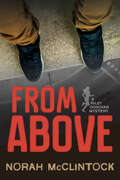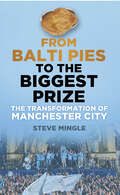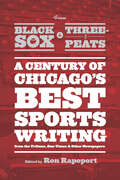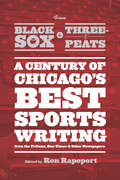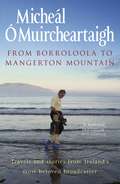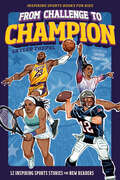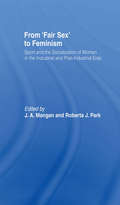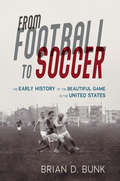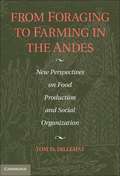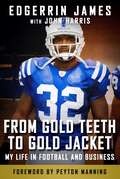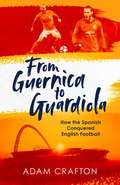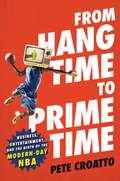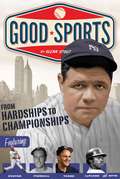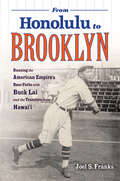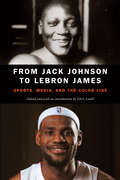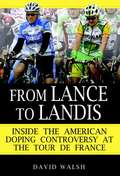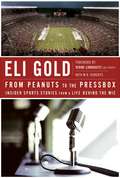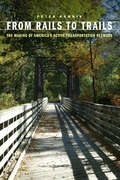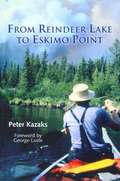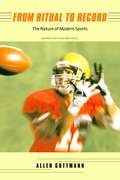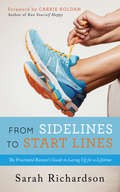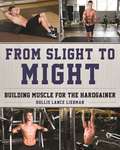- Table View
- List View
From Above: A Riley Donovan mystery (Riley Donovan #2)
by Norah McclintockWhen a football player from Riley Donovan's school falls to his death from the top of a recreation center, a hunch makes her wonder if he was pushed. But who would do such a thing, and why? <P><P>Riley's detective aunt tells Riley to leave it alone, but that's not in Riley's nature. When her friend Charlie is accused of the murder, Riley is determined to clear his name, even if it means confronting vicious junkyard dogs, forming an alliance with an old enemy, and putting her own life in danger.
From Balti Pies to the Biggest Prize: The Transformation of Manchester City
by Steve MingleThe story so far. Manchester City end the 2003-04 season relieved at having narrowly escaped relegation. There’ve been highs and lows, but the lows have been desperate and the highs restricted to minor triumphs of promotions and occasional derby wins. Meaningful silverware hasn’t been delivered since 1976. Kevin Keegan looks like he’s lost the will to live, let alone manage City, and the transfer kitty is bare. Eight years later, they’ve won the Premier League in the final seconds of the most dramatic match in the history of football. From Balti Pies to The Biggest Prize relives the journey from perpetual also-rans to champions, from laughing stocks to a team to be feared, fuelled by the injection of unimaginable finance. The money has changed the calibre of the team on the field but how much has it changed its fanbase, its culture, its soul? Steve Mingle’s book gives a unique perspective on exactly how it feels to be City today.
From Black Sox to Three-Peats: A Century of Chicago's Best Sportswriting from the Tribune, Sun-Times & Other Newspapers
by Ron RapoportBears, Bulls, Cubs, Sox, Blackhawks—there’s no city like Chicago when it comes to sports. Generation after generation, Chicagoans pass down their almost religious allegiances to teams, stadiums, and players and their never-say-die attitude, along with the stories of the city’s best (and worst) sports moments. And every one of those moments—every come-from-behind victory or crushing defeat—has been chronicled by Chicago’s unparalleled sportswriters. In From Black Sox to Three-Peats, veteran Chicago sports columnist Ron Rapoportassembles one hundred of the best columns and articles from the Tribune, Sun-Times, Daily News, Defender, and other papers to tell the unforgettable story of a century of Chicago sports. From Ring Lardner to Rick Telander, Westbrook Pegler to Bob Verdi, Mike Royko to Hugh Fullerton , Melissa Isaacson to Brent Musburger, and on and on, this collection reminds us that Chicago sports fans have enjoyed a wealth of talent not just on the field, but in the press box as well. Through their stories we relive the betrayal of the Black Sox, the cocksure power of the ’85 Bears, the assassin’s efficiency of Jordan’s Bulls, the Blackhawks’ stunning reclamation of the Stanley Cup, the Cubs’ century of futility—all as seen in the moment, described and interpreted on the spot by some of the most talented columnists ever to grace a sports page. Sports are the most ephemeral of news events: once you know the outcome, the drama is gone. But every once in a while, there are those games, those teams, those players that make it into something more—and great writers can transform those fleeting moments into lasting stories that become part of the very identity of a city. From Black Sox to Three-Peats is Chicago history at its most exciting and celebratory. No sports fan should be without it.
From Black Sox to Three-Peats: A Century of Chicago's Best Sportswriting from the Tribune, Sun-Times, and Other Newspapers
by Ron RapoportBears, Bulls, Cubs, Sox, Blackhawks--there's no city like Chicago when it comes to sports. Generation after generation, Chicagoans pass down their almost religious allegiances to teams, stadiums, and players and their never-say-die attitude, along with the stories of the city's best (and worst) sports moments. And every one of those moments--every come-from-behind victory or crushing defeat--has been chronicled by Chicago's unparalleled sportswriters. In From Black Sox to Three-Peats, veteran Chicago sports columnist Ron Rapoportassembles one hundred of the best columns and articles from the Tribune, Sun-Times, Daily News, Defender, and other papers to tell the unforgettable story of a century of Chicago sports. From Ring Lardner to Rick Telander, Westbrook Pegler to Bob Verdi, Mike Royko to Hugh Fullerton , Melissa Isaacson to Brent Musburger, and on and on, this collection reminds us that Chicago sports fans have enjoyed a wealth of talent not just on the field, but in the press box as well. Through their stories we relive the betrayal of the Black Sox, the cocksure power of the '85 Bears, the assassin's efficiency of Jordan's Bulls, the Blackhawks' stunning reclamation of the Stanley Cup, the Cubs' century of futility--all as seen in the moment, described and interpreted on the spot by some of the most talented columnists ever to grace a sports page. Sports are the most ephemeral of news events: once you know the outcome, the drama is gone. But every once in a while, there are those games, those teams, those players that make it into something more--and great writers can transform those fleeting moments into lasting stories that become part of the very identity of a city. From Black Sox to Three-Peats is Chicago history at its most exciting and celebratory. No sports fan should be without it.
From Borroloola to Mangerton Mountain: Travels and Stories from Ireland's Most Beloved Broadcaster
by Micheal O'MuircheartaighMicheál Ó Muircheartaigh is best known as the voice of the GAA. But his interests and enthusiasms – sporting and non-sporting – go far beyond the fields of Gaelic games. In his new book, the follow-up to his bestselling memoir From Dún Síon to Croke Park, Micheál brings us along on his travels around the world, and to the villages, townlands and sporting fields of the four provinces of Ireland. He recalls great days at the races and in sporting stadiums big and small, and great nights in the dance halls. Above all, he tells the stories of these places and the people he has encountered there – stories told as only Micheál can tell them.
From Challenge to Champion: 12 Inspiring Sports Stories for New Readers (Inspiring Sports Books for Kids)
by Skyler TrepelAwaken your child&’s inner champion—and love of reading—with these motivational sports stories for kids ages 6–9.Do you have a sports-obsessed kid eager to learn more about their favorite stars? Thrill them with From Challenge to Champion, a collection of stories about legendary athletes from soccer, basketball, gymnastics, baseball, and more. They&’ll learn how these athletes overcame incredible challenges—whether injury, doubt, burnout, or difficult beginnings—and emerged victorious. From Simone Biles and Serena Williams to Lionel Messi and LeBron James, each athlete&’s tale is a testament to hard work and perseverance that is sure to inspire and empower your child. Perfect for bedtime reading, classroom libraries, or as a gift to young readers, this book is sure to become a treasured early chapter book.What&’s inside?12 uplifting sports heroes. Dive into the lives of LeBron James, Serena Williams, Michael Jordan, Simone Biles, Jessica Long, Megan Rapinoe, Jackie Robinson, Allyson Felix, Patrick Mahomes, Chloe Kim, Tom Brady, and Lionel Messi—top athletes from America&’s most beloved sports.Life lessons that go beyond sports. Valuable insights on resilience, growth mindset, and the importance of believing in oneself inspire young readers to go after their own dreams.Additional athletes to know and love. 12 more short biographies of breakout stars like Caitlin Clark, Coco Gauff, and C. J. Stroud.Easy-to-read format that&’s a slam dunk for new readers. Short chapters, fun illustrations, and simple language keep kids engaged and motivated to read more.
From Fair Sex to Feminism: Sport and the Socialization of Women in the Industrial and Post-Industrial Eras (Sport in the Global Society)
by J. A. Mangan Roberta J. ParkFirst published in 1987 with the aim of deepening understanding of the place of women in the cultural heritage of modern society, this collection of essays brings together the previously discrete perspectives of women's studies and the social history of sport. Using feminist ideas to explore the role of sport in women's lives, From Fair Sex to Feminism is a central text in the study of sport, gender and the body.
From Football to Soccer: The Early History of the Beautiful Game in the United States (Sport and Society #1)
by Brian D. BunkRediscovering soccer's long history in the U.S. Across North America, native peoples and colonists alike played a variety of kicking games long before soccer's emergence in the late 1800s. Brian D. Bunk examines the development and social impact of these sports through the rise of professional soccer after World War I. As he shows, the various games called football gave women an outlet as athletes and encouraged men to form social bonds based on educational experience, occupation, ethnic identity, or military service. Football also followed young people to college as higher education expanded in the nineteenth century. University play, along with the arrival of immigrants from the British Isles, helped spark the creation of organized soccer in the United States—and the beautiful game's transformation into a truly international sport. A multilayered look at one game’s place in American life, From Football to Soccer refutes the notion of the U.S. as a land outside of football history.
From Foraging to Farming in the Andes: New Perspectives on Food Production and Social Organization
by Tom D. DillehayArcheologists have always considered the beginnings of Andean civilization from c. 13,000 to 6,000 years ago to be important in terms of the appearance of domesticated plants and animals, social differentiation, and a sedentary lifestyle, but there is more to this period than just these developments. During this period, the spread of crop production and other technologies, kinship-based labor projects, mound-building and population aggregation formed ever-changing conditions across the Andes. From Foraging to Farming in the Andes proposes a new and more complex model for understanding the transition from hunting and gathering to cultivation. It argues that such developments evolved regionally, were fluid and uneven, and were subject to reversal. This book develops these arguments from a large body of archaeological evidence, collected over 30 years in two valleys in northern Peru, and then places the valleys in the context of recent scholarship studying similar developments around the world.
From Gold Teeth to Gold Jacket: My Life in Football and Business
by John Harris Edgerrin JamesHow a young man with a solid work ethic carried himself out of poverty to the pinnacle of professional sports and business. Before he turned sixteen, Edgerrin James had already developed the critical thinking and mental discipline required for him to become one of the most astute business minds in professional sports. Acclaimed as one of the greatest running backs of his generation who was inducted into the 2020 Pro Football Hall of Fame, James is a self-made financial whiz and philanthropist. Selected by the Indianapolis Colts with the fourth overall pick in the 1999 NFL Draft and signing the largest contract for a rookie running back in league history, James amassed over 12,000 rushing yards, was a four-time NFL All-Pro, and led the league in rushing in each of his first two seasons. In his new memoir, From Gold Teeth to Gold Jacket, with award-winning sports journalist John Harris and a foreword from fellow teammate and Hall of Famer Peyton Manning, James shares his unique, no-holds-barred perspective in becoming an all-time NFL great while also building a financial empire while raising six children. The product of a single-parent household in one of the most downtrodden rural areas in the state of Florida, James balanced life as a young father as he became one of the best players in college football at the University of Miami. Later, facing what seemed like an insurmountable obstacle after reaching the pros, he overcame a devastating knee injury to leave an indelible mark on the sport. When his football career ended prematurely following the tragic death of the mother of his children, James made a seamless transition to become a successful businessman. This tell-all book, featuring colorful anecdotes from his football career and personal life delivered in conversational prose, draws parallels between sports and business and guides readers on how to develop their own personal game plan to reach their maximum potential.
From Guernica to Guardiola: How the Spanish Conquered English Football
by Adam CraftonAs Pep Guardiola shatters records and confounds the norms of English football and players such as David De Gea and David Silva light up the national game, Spanish stars are transforming the way English football is conceived. But the origins of this particular Spanish invasion date back to 1937, when the Spanish Civil War led to a stream of refugees fleeing their country for the safe haven of England. Their families reveal how the refugees learned the game here, before returning to Spain where one would score Real Madrid’s first goal in the Bernabeu stadium and another would be the first man to conceive of Barcelona’s vaunted La Masia academy that would later launch stars such as Lionel Messi, Cesc Fabregas and Xavi Hernandez. In recent years the reputation of Spain’s footballers has grown, and every club craves a sprinkling of tiki-taka magic. Through dozens of exclusive interviews, Adam Crafton has spoken to many of the key Spanish figures who have come to England and he creates a compelling portrait of their impact on the English game. We discover how and why it is that some players, such as Xabi Alonso, Pepe Reina and Juan Mata, have had great success here, while others have toiled so painfully. But this is not just a footballing story, pure and simple. Crafton provides the historical and social context that helps to explain how the relationship between the two nations is constantly changing, yet always close. For anyone who enjoyed Jonathan Wilson’s Inverting the Pyramid or Sid Lowe’s Fear and Loathing in La Liga, this book is a revealing and brilliant insight into this most benign of Spanish invasions.
From Hang Time to Prime Time: Business, Entertainment, and the Birth of the Modern-Day NBA
by Pete CroattoPerfect for fans of Moneyball and The Book of Basketball, this vivid, thoroughly entertaining, and well-researched book explores the NBA&’s surge in popularity in the 1970s and 1980s and its transformation into a global cultural institution. Far beyond simply being a sports league, the NBA has become an entertainment and pop culture juggernaut. From all kinds of team logo merchandise to officially branded video games and players crossing over into reality television, film, fashion lines, and more, there is an inseparable line between sports and entertainment. But only four decades ago, this would have been unthinkable. Featuring writing that leaps off the page with energy and wit, journalist and basketball fan Pete Croatto takes us behind the scenes to the meetings that lead to the monumental American Basketball Association–National Basketball Association merger in 1976, revolutionizing the NBA&’s image. He pays homage to legendary talents including Julius &“Dr. J&” Erving, Magic Johnson, and Michael Jordan and reveals how two polar-opposite rookies, Larry Bird and Magic Johnson, led game attendance to skyrocket and racial lines to dissolve. Croatto also dives into CBS&’s personality-driven coverage of key players, as well as other cable television efforts, which launched NBA players into unprecedented celebrity status. Essential reading whether you&’re a casual or longtime fan, From Hang Time to Prime Time is an enthralling and entertaining celebration of basketball history.
From Hardships to Championships
by Glenn StoutPraise for Good Sports:"Never patronizing, [Stout] captures both grit and glory." --Kirkus Reviews Many of the baseball greats overcame huge challenges to be sports heroes--here are five inspiring stories of men who did just that. Baseball is considered America's pastime, but not all players grew up living the American dream. Babe Ruth, Jim Peirsall, Torii Hunter, Ron LeFlore, and Joe Torre sure didn't. Poverty, abuse, and addiction are a few of the issues they had to deal with as kids, but they turned their lives around to play the game they loved.
From Heroes to Zeros: Outrageous Sports Cheaters (Fountas & Pinnell Classroom, Guided Reading Grade 4)
by Kagan McLeod Ricardo SantosNIMAC-sourced textbook
From Honolulu to Brooklyn: Running the American Empire’s Base Paths with Buck Lai and the Travelers from Hawai’i
by Joel S. FranksFrom 1912 to 1916, a group of baseball players from Hawaiʻ i barnstormed the U.S. mainland. While initially all Chinese, the Travelers became more multiethnic and multiracial with ballplayers possessing Chinese, Japanese, Hawaiian, and European ancestries. As a group and as individuals the Travelers' experiences represent a still much too marginalized facet of baseball and sport history. Arguably, they traveled more miles and played in more ball parks in the American empire than any other group of ballplayers of their time. Outside of the major leagues, they were likely the most famous nine of the 1910s, dominating their college opponents and more than holding their own against top-flight white and black independent teams. And once the Travelers’ journeys were done, a team leader and star Buck Lai gained fame in independent baseball on the East Coast of the U.S., while former teammates ran base paths and ran for political office as they confronted racism and colonialism in Hawaiʻ i.
From Jack Johnson to LeBron James: Sports, Media, and the Color Line
by Chris LambThe campaign for racial equality in sports has both reflected and affected the campaign for racial equality in the United States. Some of the most significant and publicized stories in this campaign in the twentieth century have happened in sports, including, of course, Jackie Robinson in baseball; Jesse Owens, Tommie Smith, and John Carlos in track; Arthur Ashe in tennis; and Jack Johnson, Joe Louis, and Muhammad Ali in boxing. Long after the full integration of college and professional athletics, race continues to play a major role in sports. Not long ago, sportswriters and sportscasters ignored racial issues. They now contribute to the public’s evolving racial attitudes on issues both on and off the field, ranging from integration to self-determination to masculinity.From Jack Johnson to LeBron James examines the intersection of sports, race, and the media in the twentieth century and beyond. The essays are linked by a number of questions, including: How did the black and white media differ in content and context in their reporting of these stories? How did the media acknowledge race in their stories? Did the media recognize these stories as historically significant? Considering how media coverage has evolved over the years, the essays begin with the racially charged reporting of Jack Johnson’s reign as heavyweight champion and carry up to the present, covering the media narratives surrounding the Michael Vick dogfighting case in a supposedly post-racial era and the media’s handling of LeBron James’s announcement to leave Cleveland for Miami.
From Lance to Landis: Inside the American Doping Controversy at the Tour de France
by David WalshFor eight years, the Tour de France, arguably the world's most demanding athletic competition, was ruled by two men: Lance Armstrong and Floyd Landis. On the surface, they were feature players in one of the great sporting stories of the age-American riders overcoming tremendous odds to dominate a sport that held little previous interest for their countrymen. But is this a true story, or is there a darker version of the truth, one that sadly reflects the realities of sports in the twenty-first century?
From Peanuts to the Pressbox
by Eli GoldIn this behind-the-scenes look at sports broadcasting Eli Gold tells how a kid from Brooklyn, New York, went from selling peanuts at Madison Square Garden to being one of the most recognizable voices in all of radio sports broadcasting. From Peanuts to the Pressbox is an intimate walk down memory lane, reliving some of the greatest moments in Alabama sports (basketball and football) and NASCAR. Gold also shares stories from his early days with Yankees broadcaster Mel Allen and Red Barber and other broadcasting greats, such as Bob Costas, Tom Hammond, Verne Lundquist, Kevin Harlan, Ron Franklin, and Mike Tirico.
From Rails to Trails: The Making of America's Active Transportation Network
by Peter HarnikIf, as Wallace Stegner said, the national park is &“the best idea we ever had,&” the rail-trail is certainly a close runner-up. Part transportation corridor, part park, the rail-trail has revolutionized the way America creates high-quality, car-free pathways for bicyclists, runners, walkers, equestrians, and more. It was only a few decades after railroad barons had run roughshod over America&’s economy and politics that they began to shed nearly one hundred thousand miles of unneeded railroad corridor. At the same time, bicyclists were being so thoroughly pushed off ever-more-intimidating roadways they came close to extinction. Through political organizing and lawyerly grit, an unlikely, formerly marginalized advocacy arose, seized on seemingly worthless strips of land, and created a resource that is treasured by millions of Americans today for recreation, purposeful travel, tourism, conservation, and historical interpretation.From Rails to Trails is the fascinating tale of the rails-to-trails movement as well as a consideration of what the continued creation of rail-trails means for the future of Americans&’ health, nonmotorized transportation networks, and communities across the country.
From Reindeer Lake to Eskimo Point
by Peter Kazaks George LusteCanoe across large lakes, up and down rivers and rapids; labour over portages and through a miasma of blackflies; bask in the golden evenings of the Subarctic. In this account of an 800-mile canoe trip – which begins at Reindeer Lake on the Manitoba/Saskatchewan border, continues into Nunavut past the treeline, and ends on Hudson Bay – Peter Kazaks conveys the experience of being in the north by describing the daily details that bring the trip to life. He captures the flavour of an extended wilderness canoe trip and reflects on living in unfettered wilderness. The reader will also grasp something of the serene beauty of the barren lands and begin to understand why its intoxicating nature keeps drawing some back. The first half of the trip, essentially from Reindeer Lake to Nueltin Lake, retraces P.G. Downes’ voyage described in his classic Sleeping Island. Next the four men of this expedition, led by George Luste, entered the barren lands and followed the Thlewiaza River, the Kognak River, South Henik Lake and the Maguse River north and east to the shore of Hudson Bay. These lands, seldom visited, are close to a true wilderness – one of the few remaining ones.
From Ritual to Record: The Nature of Modern Sports
by Allen GuttmannOriginally published in 1978, From Ritual to Record was one of the first books to recognize the importance of sports as a lens on the fundamental structure of societies. In this reissue, Guttmann emphasizes the many ways that modern sports, dramatically different from the sports of previous eras, have profoundly shaped contemporary life.
From Ritual to Record: The Nature of Modern Sports, updated edition
by Allen GuttmannOriginally published in 1978, From Ritual to Record was one of the first books to recognize the importance of sports as a lens on the fundamental structure of societies. In this reissue, Guttmann emphasizes the many ways that modern sports, dramatically different from the sports of previous eras, have profoundly shaped contemporary life.
From Rocky Waters to a Smooth Finish: Neal Petersen's Story (Fountas & Pinnell LLI Purple #Level S)
by Helen ScullyBorn dark-skinned in South Africa and with a missing hip joint, Neal Petersen faced many challenges to achieve his dream of sailing around the world.
From Sidelines to Startlines: The Frustrated Runner's Guide to Lacing Up for a Lifetime
by Sarah RichardsonIt's Your Life. Rise Up and Run with It. From Sidelines to Start Lines is for former runners who are feeling frustrated and like frauds for sitting on the couch or behind the computer for far too many days (or years). If you want to get back into running to improve your health, your social life, and your sanity, this book is for you. When you clarify what has really been holding you back and keeping you from logging your miles, you will be free to train effectively for any race and victoriously cross any finish line. Drawing from her own experience as a runner who had to overcome a four-year hiatus and her work with run-ning clients, Sarah Richardson carefully explains what it takes to successfully re-create healthy running habits in your busy life. While training plans and books about running are easy to come by, From Sidelines to Start Lines takes it a step further. Rather than just telling you what you should do, what you should buy, and how far to run, Sarah Richardson helps frustrated runners deal with the Inner Game that often keeps people sidelined. She teaches you how to lay a solid running foundation with four supportive pillars that will create a joyful, personal, and sustainable running plan. With practical activities and real-life examples, this book will teach you how to commit to rather than resist your practice.
From Slight to Might: Building Muscle for the Hardgainer
by Hollis Lance LiebmanAre you discouraged at the gym? You see all those muscular men lifting double your weight with ease, but when you look in the mirror, all that’s looking back at you is a skinny guy longing for bulk. Well the days of thinking that you’ll never be muscular are long but over. Now you have the opportunity to bulk up with ease! How you say? Well just pick up a copy of From Slight to Might and find out! <p><p> From fitness guru Hollis Lance Liebman comes a book that not only shows you the right way to begin your workouts, but how to train for the future in both the gym and at home. Shown through Liebman’s three phases of progressive change, you’ll be able to see noticeable improvements to you physique in just a few months. Many people waste hours in the gym doing exercises incorrectly or using too much weight. Then you have those who sweat the fat off and then go home to an unhealthy meal. Liebman touches on this and more by not only showing you the proper form for each exercise, but how to also improve your diet and personal mindset (along with your body). <p> With full-color photographs and step-by-step instructions, From Slight to Might will help you add the bulk you’ve been seeking and continue to gain personal confidence in your body. Your mood will improve, your clothes will fit better, and you’ll feel like a better person by getting in shape, bulking up, and learning the right way to live that you’ve always been yearning for.
